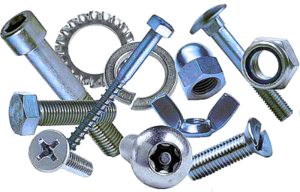Nuts, Bolts and Washers: Difference between revisions
From DT Online
(Added Section Structure) |
m (Added headings) |
||
| Line 18: | Line 18: | ||
{| | {| | ||
|- | |- | ||
| [ | | '''Hexagonal''' | ||
| B | |||
| [[File:###|200px|right]]| | |||
|- | |||
|'''Square''' | |||
| B | |||
| [[File:###|200px|right]] | |||
|- | |||
| '''Round''' | |||
| B | |||
| [[File:###|200px|right]] | |||
|- | |||
| '''Countersunk''' | |||
| B | | B | ||
| [[File:###|200px|right]] | | [[File:###|200px|right]] | ||
| Line 26: | Line 38: | ||
{| | {| | ||
|- | |- | ||
| [ | | [https://en.wikipedia.org/wiki/Hex_key '''Allen Screws'''] | ||
| B | | B | ||
| [[File:###|200px|right]] | | [[File:###|200px|right]] | ||
| Line 34: | Line 46: | ||
{| | {| | ||
|- | |- | ||
| [ | | [https://en.wikipedia.org/wiki/Set_screw '''Grub Screws'''] ''(aka Set Screws)'' | ||
| B | | B | ||
| [[File:###|200px|right]] | | [[File:###|200px|right]] | ||
| Line 42: | Line 54: | ||
{| | {| | ||
|- | |- | ||
| [ | | '''Hexagonal''' | ||
| B | |||
| [[File:###|200px|right]]| | |||
|- | |||
|'''Square''' | |||
| B | |||
| [[File:###|200px|right]] | |||
|- | |||
| '''Locking Nut''' | |||
| B | |||
| [[File:###|200px|right]] | |||
|- | |||
| '''Wing Nut''' | |||
| B | | B | ||
| [[File:###|200px|right]] | | [[File:###|200px|right]] | ||
| Line 50: | Line 74: | ||
{| | {| | ||
|- | |- | ||
| [ | | '''Plain''' | ||
| B | |||
| [[File:###|200px|right]]| | |||
|- | |||
|'''Spring''' | |||
| B | |||
| [[File:###|200px|right]] | |||
|- | |||
| '''Repair''' | |||
| B | |||
| [[File:###|200px|right]] | |||
|- | |||
| '''Spring''' | |||
| B | | B | ||
| [[File:###|200px|right]] | | [[File:###|200px|right]] | ||
| Line 58: | Line 94: | ||
{| | {| | ||
|- | |- | ||
| [ | | [https://en.wikipedia.org/wiki/Threaded_rod '''Studs'''] | ||
| B | | B | ||
| [[File:###|200px|right]] | | [[File:###|200px|right]] | ||
Revision as of 20:10, 18 August 2015
Nuts and Bolts are avilable in a wide variety of sizes, types of screw thread, shapes of head and materials to provide a very commonly used means of fastening components together such that they can be removed if needed.
A screw thread is one of the Basic Machines comprising a small thread cross-section wrapped around a cylinder as a Helix - which in itself can be simulated by wrapping a triangle around a cylinder. It follows that coarser threads have bigger thread cross sections and are therefore stronger, especially in softer materials, but fine threads follow the Helix traced by a more Acute angled triangle and grip tighter because they are a thinner Wedge or Inclined Plane - (e.g. the cylinder head Studs of a high revving engine may have fine threads at the top to resist vibration but coarse threads where they screw into the soft aluminium crankcase).
Machine Screws are very similar to Bolts except that, in general, Bolts have a plain section of shank below the head whereas Machine Screws are threaded right up to the head.
Sizes are now most commonly standardised in terms of their diameter in millimetres (e.g. a 10mm bolt has an external diameter of 10mm) although British Association (B.A.) threads may still occasionally be found in the smaller sizes of screws. Older, now largely obsolete, standards include British Standard Whitworth (i.e. B.S.W.; B.S.F.; B.S.C. and B.S.B.), British Standard Pipe (or B.S.P. in which the size number was originally based on the inner diameter of a steel tube for which the external thread was intended), and the American Unified Thread Standard (i.e. U.N.C. and U.N.F.) - which are still in use in USA and Canada although there is movement towards the increasingly universal ISO Metric standard.
Bolt and Screw Head Shapes
| Hexagonal | B | [[File:###|200px|right]]| |
| Square | B | [[File:###|200px|right]] |
| Round | B | [[File:###|200px|right]] |
| Countersunk | B | [[File:###|200px|right]] |
Cap Screws
| Allen Screws | B | [[File:###|200px|right]] |
Grub Screws
| Grub Screws (aka Set Screws) | B | [[File:###|200px|right]] |
Types of Nut
| Hexagonal | B | [[File:###|200px|right]]| |
| Square | B | [[File:###|200px|right]] |
| Locking Nut | B | [[File:###|200px|right]] |
| Wing Nut | B | [[File:###|200px|right]] |
Washers
| Plain | B | [[File:###|200px|right]]| |
| Spring | B | [[File:###|200px|right]] |
| Repair | B | [[File:###|200px|right]] |
| Spring | B | [[File:###|200px|right]] |
Studs
| Studs | B | [[File:###|200px|right]] |
